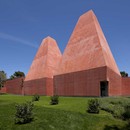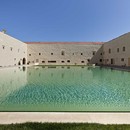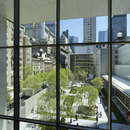Biography
A native of Lausanne, Bernard Tshumi (1944) is unanimously considered to be one of the leading interpreters of Deconstructivism.
Born into the art (his father was Jean Tschumi, 1904-1962), he graduated from the ETH in Zurich in 1969. He has dual Swiss and French nationality, and lives and works between Paris and New York.
In the 1970s Tshumi taught at the Architectural Association of London, then at Princeton and Cooper Union, and from 1988 to 2003 he was Dean of the Graduate School of Architecture at Columbia University in New York.
In addition to teaching activity, the early part of his career focused mainly on his reflections on the issues in architecture. In this period, which coincided with all the Seventies and the early Eighties, Tshumi mostly played a theoretical role, writing important critical essays.
Despite his proximity at a young age with environments linked to the traditional architecture carried out by his father, Tschumi's education was fundamentally influenced by the post-1968 period and led him to theorize a multidisciplinary approach, involving music, cinema, literature, and visual and performing arts, just to mention the main areas.
In this "vague terrain", as he himself defined it, he developed a personal vision of the discipline “in which certain exponents of the French structuralist movement, such as Foucault, Bataille, and Derrida, played an important role” (Jetzer).
For Tschumi, architecture “can no longer be simply a way of organizing spaces, but a modality of experience and a way of living.”
It can also be stated, in a synthetic and effective manner that "it is his conviction that architecture is first of all a form of knowledge and only afterward a knowledge of form." (T. O'Connell)
This period flows into a series of exhibitions and installations "that are situated at the edge of conventionally understood architecture and propose an anti-functionalist and more avant-gardist approach, in the sense of the Futurist and Constructivist avant-gardes." (Treccani).
During these years he published the important essays Manifestoes (1978) and The Manhattan Transcripts (1981), the aim of which "is to demonstrate the relationships of disjunction, of dissociation between space and use, between form and programme (function): an architectural transcription of reality by means of a story of love and death in Manhattan."
This theme would also be at the centre of the subsequent collection of essays Architecture and Disjunction (1994).
Applying these eclectic and innovative positions, in 1983 Tschumi won the competition for the general plan for the Parc du XX Siècle at the Villette in Paris.
Completed in 1998, the Parc is his most famous project and one of the best-known architectural complexes in the deconstructivist style.
A complex work rich in constructive tension, in the Parc “the concepts of repetition, discontinuity, rupture, fragmentation, transformation and superimposition, which are the basis of his research, are finally given concrete form in a large-scale project.” (A. Carbone).
Subsequently, Tschumi addressed many urban planning issues, working on masterplans and competitions with his firm. The many works of the last two decades include the National Contemporary Art Centre in Lille (1998); Alfred Lerner Hall at Columbia University in New York (1999); the schools of architecture in Marne-la-Vallée (2001) and of Florida International University in Miami (2003); the headquarters of Vacheron Constantin in Geneva (2005); the Limoges Concert Hall (2007); the Blue Tower in New York (2004-06); and the Museum of the Acropolis in Athens (2009).
In 2018 his firm was awarded the highly important project for a new research centre at the Université Paris-Sud. Once completed, the education and research centre for the life science disciplines of biology, pharmaceutics and chemistry will be one of the largest research establishments in France.
Situated on 74,000 square metres, the centre will have teaching facilities, offices and research laboratories, as well as restaurants, four auditoriums, a museum, and large public areas. The concept of the work envisages six buildings connected by an interior street, which will be the "common denominator" and a social space for the entire complex.
Set to open in 2019, the Tianjin Binhai Exploratorium in Tientsin, China, is an impressive project of 33,000 square metres. The building will contain the city’s industrial artefacts and a series of large exhibition halls as well as multipurpose and commercial spaces.
Visually, the structure is striking due to the presence of large cones, for a new spatial experience (the roof overlooks the city, the main open space is an access point for every part of the complex).
As Tschumi said, “The Exploratorium is designed as a building for the past, present and future of Tianjin.” In its structure and in the large spaces of circulation, both industrial archetypes and more contemporary elements, such as the futuristic circular lightwells, coexist in a single overall image.
The exhibitions dedicated to Tschumi include the retrospective Concept & Notation dedicated to him by the Centre Pompidou (April-July 2014), with 350 various objects (drawings, films, collages), collected by theme, that follow the evolution of his poetics since the Seventies.
Bernard Tshumi selected works and projects
- Tianjin Binhai Exploratorium, Tientsin (Cina), 2019
- University Paris-Sud, Parigi (Francia), 2018 - in corso
- Paul & Henri Carnal Hall - Institut Le Rosey, Rolle (Svizzera), 2014
- Zoo, Parigi (Francia), 2014
- Progetto Carnal Dome, Rolle (Svizzera), 2013
- Museo e Parco Archeologico di Alésia (Francia), 2012
- Museo dell’Acropoli, Atene (Grecia), 2009
- Progetto di masterplan Mediapolis, Singapore, 2008
- Blue Tower, New York (USA), 2007
- Concert Hall, Limoges (Francia), 2006
- Sede Vacheron Constantin, Ginevra (Svizzera), 2005
- Facoltà di Architettura - Università della Florida, Miami (USA), 2003
- Interfaccia Flon transport system, Losanna (Svizzera), 2002
- Centro Atletico - Università di Cincinnati (USA), 2001
- Museo d’Arte Contemporanea, San Paolo (Brasile), 2001
- Sala da concerto e centro espositivo, Rouen (Francia), 2001
- Facoltà di Architettura, Marne-la-Vallée, Parigi (Francia), 2001
- Stazione, Flon, Losanna (Svizzera), 2001
- Progetto Carnegie Science Center, Pittsburgh (USA), 2000
- Museo d’Arte Africana, New York (USA), 2000
- Urban Glass House, New York (USA), 2000
- Alfred Lerner Hall - Columbia University, New York (USA), 1999
- Parc de la Villette, Parigi (Francia), 1998
- Centro nazionale d’arte contemporanea, Le Fresnoy, Tourcoing (Francia), 1997
Born into the art (his father was Jean Tschumi, 1904-1962), he graduated from the ETH in Zurich in 1969. He has dual Swiss and French nationality, and lives and works between Paris and New York.
In the 1970s Tshumi taught at the Architectural Association of London, then at Princeton and Cooper Union, and from 1988 to 2003 he was Dean of the Graduate School of Architecture at Columbia University in New York.
In addition to teaching activity, the early part of his career focused mainly on his reflections on the issues in architecture. In this period, which coincided with all the Seventies and the early Eighties, Tshumi mostly played a theoretical role, writing important critical essays.
Despite his proximity at a young age with environments linked to the traditional architecture carried out by his father, Tschumi's education was fundamentally influenced by the post-1968 period and led him to theorize a multidisciplinary approach, involving music, cinema, literature, and visual and performing arts, just to mention the main areas.
In this "vague terrain", as he himself defined it, he developed a personal vision of the discipline “in which certain exponents of the French structuralist movement, such as Foucault, Bataille, and Derrida, played an important role” (Jetzer).
For Tschumi, architecture “can no longer be simply a way of organizing spaces, but a modality of experience and a way of living.”
It can also be stated, in a synthetic and effective manner that "it is his conviction that architecture is first of all a form of knowledge and only afterward a knowledge of form." (T. O'Connell)
This period flows into a series of exhibitions and installations "that are situated at the edge of conventionally understood architecture and propose an anti-functionalist and more avant-gardist approach, in the sense of the Futurist and Constructivist avant-gardes." (Treccani).
During these years he published the important essays Manifestoes (1978) and The Manhattan Transcripts (1981), the aim of which "is to demonstrate the relationships of disjunction, of dissociation between space and use, between form and programme (function): an architectural transcription of reality by means of a story of love and death in Manhattan."
This theme would also be at the centre of the subsequent collection of essays Architecture and Disjunction (1994).
Applying these eclectic and innovative positions, in 1983 Tschumi won the competition for the general plan for the Parc du XX Siècle at the Villette in Paris.
Completed in 1998, the Parc is his most famous project and one of the best-known architectural complexes in the deconstructivist style.
A complex work rich in constructive tension, in the Parc “the concepts of repetition, discontinuity, rupture, fragmentation, transformation and superimposition, which are the basis of his research, are finally given concrete form in a large-scale project.” (A. Carbone).
Subsequently, Tschumi addressed many urban planning issues, working on masterplans and competitions with his firm. The many works of the last two decades include the National Contemporary Art Centre in Lille (1998); Alfred Lerner Hall at Columbia University in New York (1999); the schools of architecture in Marne-la-Vallée (2001) and of Florida International University in Miami (2003); the headquarters of Vacheron Constantin in Geneva (2005); the Limoges Concert Hall (2007); the Blue Tower in New York (2004-06); and the Museum of the Acropolis in Athens (2009).
In 2018 his firm was awarded the highly important project for a new research centre at the Université Paris-Sud. Once completed, the education and research centre for the life science disciplines of biology, pharmaceutics and chemistry will be one of the largest research establishments in France.
Situated on 74,000 square metres, the centre will have teaching facilities, offices and research laboratories, as well as restaurants, four auditoriums, a museum, and large public areas. The concept of the work envisages six buildings connected by an interior street, which will be the "common denominator" and a social space for the entire complex.
Set to open in 2019, the Tianjin Binhai Exploratorium in Tientsin, China, is an impressive project of 33,000 square metres. The building will contain the city’s industrial artefacts and a series of large exhibition halls as well as multipurpose and commercial spaces.
Visually, the structure is striking due to the presence of large cones, for a new spatial experience (the roof overlooks the city, the main open space is an access point for every part of the complex).
As Tschumi said, “The Exploratorium is designed as a building for the past, present and future of Tianjin.” In its structure and in the large spaces of circulation, both industrial archetypes and more contemporary elements, such as the futuristic circular lightwells, coexist in a single overall image.
The exhibitions dedicated to Tschumi include the retrospective Concept & Notation dedicated to him by the Centre Pompidou (April-July 2014), with 350 various objects (drawings, films, collages), collected by theme, that follow the evolution of his poetics since the Seventies.
Bernard Tshumi selected works and projects
- Tianjin Binhai Exploratorium, Tientsin (Cina), 2019
- University Paris-Sud, Parigi (Francia), 2018 - in corso
- Paul & Henri Carnal Hall - Institut Le Rosey, Rolle (Svizzera), 2014
- Zoo, Parigi (Francia), 2014
- Progetto Carnal Dome, Rolle (Svizzera), 2013
- Museo e Parco Archeologico di Alésia (Francia), 2012
- Museo dell’Acropoli, Atene (Grecia), 2009
- Progetto di masterplan Mediapolis, Singapore, 2008
- Blue Tower, New York (USA), 2007
- Concert Hall, Limoges (Francia), 2006
- Sede Vacheron Constantin, Ginevra (Svizzera), 2005
- Facoltà di Architettura - Università della Florida, Miami (USA), 2003
- Interfaccia Flon transport system, Losanna (Svizzera), 2002
- Centro Atletico - Università di Cincinnati (USA), 2001
- Museo d’Arte Contemporanea, San Paolo (Brasile), 2001
- Sala da concerto e centro espositivo, Rouen (Francia), 2001
- Facoltà di Architettura, Marne-la-Vallée, Parigi (Francia), 2001
- Stazione, Flon, Losanna (Svizzera), 2001
- Progetto Carnegie Science Center, Pittsburgh (USA), 2000
- Museo d’Arte Africana, New York (USA), 2000
- Urban Glass House, New York (USA), 2000
- Alfred Lerner Hall - Columbia University, New York (USA), 1999
- Parc de la Villette, Parigi (Francia), 1998
- Centro nazionale d’arte contemporanea, Le Fresnoy, Tourcoing (Francia), 1997
Official web site
Related Articles: Bernard Tschumi
Related Articles









